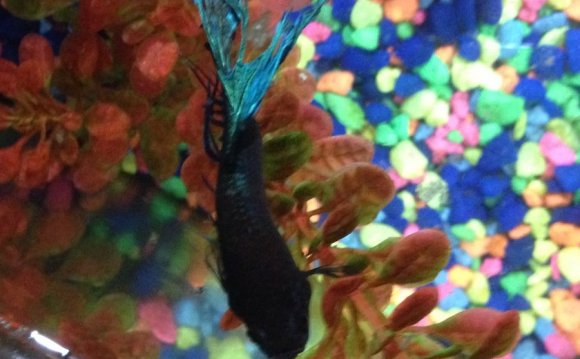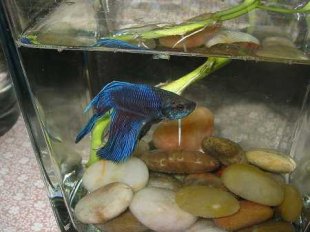
 Bettas can be vulnerable to a variety of illnesses. Knowing how to distinguish specific symptoms is essential so you can take immediate steps to isolate the sick betta and protect the other fish in the tank. Even if you don't have other fish in the tank, using a one-gallon fish bowl for your sick fish will make it easier to administer medications. Just make sure that you use the same tank water from his usual tank to avoid an abrupt change in his immediate environment.
Bettas can be vulnerable to a variety of illnesses. Knowing how to distinguish specific symptoms is essential so you can take immediate steps to isolate the sick betta and protect the other fish in the tank. Even if you don't have other fish in the tank, using a one-gallon fish bowl for your sick fish will make it easier to administer medications. Just make sure that you use the same tank water from his usual tank to avoid an abrupt change in his immediate environment.
Before familiarizing yourself with common symptoms of various health problems affecting Betta fish, it is important to know how to distinguish between a healthy and sick betta.
Signs that are commonly observed in a sick betta include:
- Loss of appetite; may eat and spit out his food.
- Lethargic; may lay at the bottom of the tank and only come up to the surface for air.
- May dart and rub their body on tank décor and substrate in an effort to scratch themselves.
- Appears to have a dull color, pale, and may turn gray.
- Tails or fins may be clumped, closed, stiff, or falling apart.
- Appearance of red spots, open sores, white cottony patches, lumps or white spots on their body.
- Eyes may be swollen or protruding, and may appear cloudy.
- Scales are raised.
- Belly looks abnormally swollen, big, or too hollow.
Here are some common Betta health problems and their symptoms to help you diagnose and treat the condition.
`Tail Rot or Fin Rot
- Fins and/or tail appear to be getting shorter or falling apart
- Infected areas may appear reddish
Cotton Wool Disease (Flex, Flexibacter columnaris)
- Cottony appearance, which many aquarists may mistake for a fungal infection.
- White, yellowish-brown, or whitish-gray growth on the body, fins, or mouth. The cotton tufts may also appear across the top of the fish creating a "saddle back" appearance.
- Redness around the infected site, lethargy, loss of appetite, and rubbing their body against tank décor or substrate.
Betta Popeye (Exopthalmia)
- Cloudy, protruding eye or a large bubble that covers the region around his eyes. The condition may affect one or both eyes.
Ick
- White dots spread all over the body and head of the fish.
- Clamped fins.
Velvet
- Clamped fins
- Poor appetite
- Darting
- Rubbing against aquarium décor and substrate
- Loss of color
- Lethargic
Dropsy
- Bloated belly
- Raised scales
- Fish may appear like a pine cone
Swim Bladder Disease (SBD) or Bloat
- Betta has trouble swimming, can't stay upright, or only swim on his side.
Parasites
- Examine closely the area around the fins and gills
- Fish may dart and rub against tank décor
- Color loss
- Lethargy
- Fish with internal parasites may lose weight and appear lethargic but has normal appetite
Tuberculosis
Warning: This is a potentially fatal disease that humans can get from handling fish infected with tuberculosis.
- Affected fish may just die suddenly without showing distinct signs of illness
- Other symptoms include presence of open sores, body deformities such as a bent spine, raised scales, fin and tail rot, and generalized gray lesions.
Septicemia (Red Streaks)
- Bloody red streaks across the betta's body and/fins
- Bloating
- Ulcers
- Gasping for air
Body Slime Infection
- Betta is covered in a white film that may be raised in some areas of the body
- Cloudy eyes
Betta Puffy Gills
- Inflamed, reddish gills
- Gasping for breath
About the Author:
Peter Hartono is the founder and CEO of Just Aquatic - a proud Australian company that offers homegrown aquatic plants and aquarium supplies carrying top of the line brands including API, biOrb and Exo Terra. To find out more of our exciting offers and promotions check out our Facebook Page and follow us on Twitter at @justaquatic.









